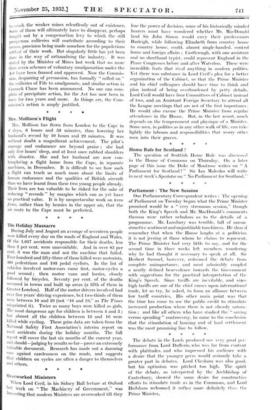The Holiday Massacre During July and August an average of
seventeen people were killed every day on the roads of England and Wales. Of the 1,017 accidents responsible for their deaths, less than 2 per cent, were unavoidable. And in over 85 per cent, it was the man and not the machine that failed. Four hundred and fifty-three of those killed were motorists, 406 pedestrians and 193 pedal cyclists. In the list of vehicles involved motor-cars came first, motor-cycles a good second ; then motor vans and lorries, closely followed by bicycles. Seventy per cent. of the deaths occurred in towns and built up areas (a fifth of them in Greater London). Half of the motor drivers involved had over five years' driving experience, but two-thirds of them were between 16 and 29 (not "16 and 19," as The Times misprinted it). Twice as many boys were killed as girls. The most dangerous age for children is between 4 and 5; but almost all the children between 13 and 16 were killed while cycling. These grim data are taken from the National Safety First Association's interim report on road accidents during the holiday months. The full report will cover the last six months of the current year, and should—judging by results so far—prove an extremely valuable document. Research has made out a damning ease against carelessness on the roads, and suggests that children on cycles arc often a danger to themselves and others.






































 Previous page
Previous page